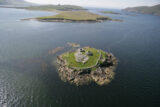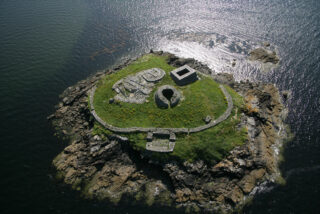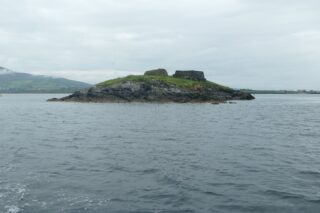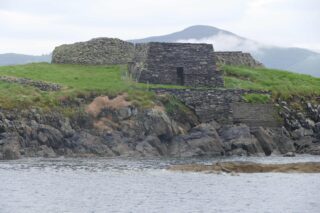Notice
Church Island is a state-owned National Monument in the care of the Office of Public Works
WARNING: It should be noted that these sites are unguided and a level of care and caution should be maintained during all stages of your visit. The Office Of Public Works (OPW) will not be held responsible for any damages, injuries, or losses that occur
Church Island – Valentia Harbour
On a small and exposed island in Valentia harbour stands Church Island, home to an early medieval monastic settlement and iron smelting. The island was excavated in 1955-56 by M.J. O’Kelly, noted Irish archaeologist, who found the occurrence of two phases of Early Medieval occupation and temporary Later Medieval occupation.
The earliest features are a circular wooden hut and rectangular wooden building, thought to be an oratory, found near the middle of the island. The occupational layer of the hut included charcoal, shells, and animal bones. The wooden oratory is found between the hut and west shore, identifiable by post-holes. A cemetery of at least thirty-three burials is found north and north-west of the wooden oratory.
It is suggested that the second phase followed directly after the first phase of occupancy. Both the wooden hut and wooden oratory were replaced by a stone circular house and stone oratory. Eight of the burials are said to be contemporary to the stone oratory. The excavation also found two stone crosses, two cross slabs, and an ogham inscribed cross slab.
When these wooden structures were replaced with stone structures some of the wooden features were copies as skeuomorphs. Such was the case for Church Island when a finial carved from micaceous sandstone was found. It is thought to be a carving of the Orans, a medieval position of prayer. The finial was an architectural link from the wood to the stone.
An ogham stone located near the south-west shore shows an incised Maltese cross, central circle and four smaller circles joined by four petals with truncated tips. The ogham inscription reads: BECCDINN MACI RIT(T)AVVECASS and is dated 650 to 750 AD.
Two shrines are found to the south of the island. Shrine 1, was partially excavated in 2004, measures 26m with surfaces paved with Valentia slate and white quartz pebbles. It is suggested that it was a tent-shaped gable-shrine. Traces of at least four individuals were found during excavation. Shrine 2, was trapezoidal in shape and excavation determined that the contents of the shrine were disturbed but had probably once held human remains.
Visit Historic Environment Viewer for more information on Church Island - Valentia
Protect our Past - Click here to read about the importance of protecting our country’s unique heritage sites
This national monument is protected in accordance with the National Monuments Acts 1930 to 2014
Gallery
Nearby sites to visit
Daniel O’Connell House – Derrynane House
The childhood home of Daniel O’Connell
Approx. 22.1 km from Church Island – Valentia Harbour
Sceilg Mhichíl UNESCO World Heritage Property
An island monastery towering over the sea
Approx. 24.4 km from Church Island – Valentia Harbour
Ionad an Bhlascaoid – The Blasket Centre
The story of a remarkable island community
Approx. 24.9 km from Church Island – Valentia Harbour
Ross Castle
A lakeside citadel steeped in legend
Approx. 52.8 km from Church Island – Valentia Harbour
Ardfert Cathedral
A trio of medieval churches devoted to St Brendan
Approx. 55.3 km from Church Island – Valentia Harbour
Ilnacullin – Garinish Island
An island garden of rare beauty
Approx. 55.6 km from Church Island – Valentia Harbour





